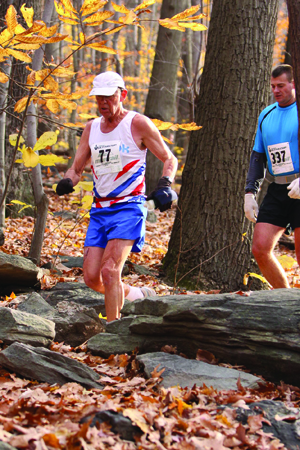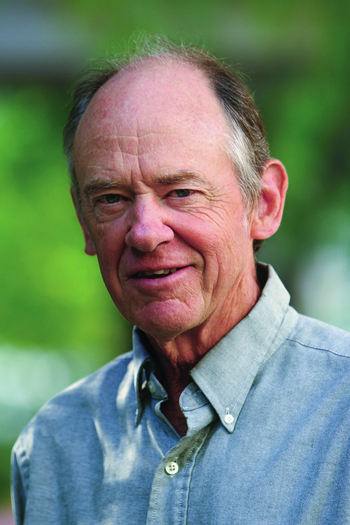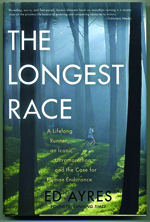Long-Run Prospects
A coda to that article I wrote for the Swarthmore College Bulletin 46 years ago

Ed Ayres ’63 competes in the JFK 50-mile, the nation’s oldest and most iconic ultramarathon. He has run in more than 600 long-distance races, including finishing third in the inaugural New York City Marathon.
For the October 1966 Bulletin, three years after my graduation, I wrote an article with the whimsical title “What Are You Running in Your Underwear For?” It was not common to see people running along public roads in those days, and the bright athletic apparel we have now was not yet available in stores. All we had was our old gym shorts. But taunts from intoxicated young men in passing cars not withstanding, I wasn’t deterred from my pursuit of an activity that had become, for me, a great adventure. The article included this passage:
The 14,000 miles I have run (including 600 miles of races) have given me an unparalleled education. I have learned a lot of things about muscles and time, and how to keep warm in a snowstorm when dressed for the beach. I have found myself more capable of seeing some of life’s most ordinary phenomena in extraordinary perspective. …
Now, 46 years later, I’m still running and racing, and my 14,000 miles are more like 140,000, and the “unparalleled education” has continued but not on the course I might have envisioned in 1966. It’s been more like what the maverick author and environmentalist Edward Abbey invoked when he wrote, “May your trails be crooked, winding, lonesome, dangerous, leading to the most amazing view.”
A quarter-century after my Bulletin article was published I found myself on a literally crooked, winding, and dangerous trail—conceivably the same trail that the ill-fated Donner party hiked in 1847 before dying of cold and starvation. It was a trail that would lead to a series of linked perspectives that were not just “extraordinary,” as I’d written in 1966, but profoundly disturbing and, for me, life changing.
I was in my mid-40s and had decided to enter the famous Western States 100-Mile Endurance Run, which follows old gold-prospectors’ trails over California’s Sierra Nevada mountains. By then I’d been working as an environmental editor for years, but in that race I gained a very humbling new perspective on the nature of energy efficiency. I had assumed I’d burn about 130 calories per mile, so I’d need 13,000 calories, which I’d supply by consuming 80 PowerBars as I ran. But by the time I’d gone a little more than half the distance, I was deathly ill—and out of the race. How were the other guys able to keep going? Only later did I learn that evolution has created a kind of bodily ecology that with training enables very small amounts of carbohydrate to interact with small amounts of fat to generate a far more efficient propulsion than I’d thought possible. So, there was the first of my linked perspectives: Energy efficiency, it turned out, was a far bigger factor than supply in determining one’s ability to run over rough terrain all day and all night.
Later, in my work as a science editor at the Worldwatch Institute, I’d been noticing striking parallels between what I’d had to do to develop endurance as an individual human and what environmental scientists were saying we’ll have to do to achieve sustainability as a global civilization. But I also noticed that in our rushing world, especially in America, we seem to seek ever-greater power and speed in all things. We want fast cars, fast food, fast communications, fast new product development, and very fast returns on investment. The quantity of carbon fuel we burn in a day may have taken the Earth 100,000 days of photosynthesis to produce.

Ed Ayres is the founding editor and publisher of Running Times magazine and former editor of Worldwatch magazine.
As ecologists put it, we are hugely exceeding our planet’s carrying capacity—much as a sprinter’s output exceeds his oxygen capacity and is therefore sharply truncated. In much of the world, now, and especially in America, we live in a sprint culture. Scientists have tried to warn us, but we aren’t listening.
Some of the scientists say that at current rates of consumption and ecological debt building, we may have only a few decades before catastrophe. A few decades in evolutionary time is the equivalent of—you guessed it—a minute or so for a sprinter. If we really do want a sustainable society, we’ll need to embrace some of the same principles of industrial and community management that long-distance runners are discovering about themselves.
That brings me to a perspective that offers a panoramic connecting of our prehistoric past with our now-endangered future. In my early years at Running Times, a magazine I launched in 1977 (now published by Rodale Press), we published four articles about the Tarahumara Indians of Mexico’s remote Baranca del Cobre (Copper Canyon), under the title “If They Don’t Run, They Don’t Eat.” Living much as prehistoric humans had, the Tarahumara used their long-distance running prowess to chase down faster animals by outlasting them.
A few months after the fourth article appeared, the first scientific article proposing a new “persistence hunting” theory of human evolution was published by David Carrier, a University of Utah biology graduate student. Carrier managed to persuade his mentor, Dennis Bramble, that the theory might be an important breakthrough. Daniel Lieberman at Harvard joined them, and the theory was later featured as a cover story in the journal Nature. Their truly remarkable conclusion: Early humans, despite being physically more frail and slow-footed than many other mammals, became the planet’s dominant species by outrunning those animals. The bigger creatures had dangerously sharp teeth and claws, or horns or other lethal weapons, but after a series of escapes from hominids carrying rocks or spears, they were overheated and exhausted. A band of humans—the original cross-country team!—could take down the bigger prey.
We don’t really know what went on in the minds of those early persistence hunters, but I’d guess that in a long day of tracking and chasing, the animal being pursued was out of sight much of the time—having left the scene minutes or hours before, or having sprinted out of sight, when spotted, into a thicket or around a bend. Yet, the humans could not succeed in the hunt—and have dinner that night and survive and evolve—without continuing to “see” the quarry in some sense, perhaps as an evolving mental construct like the digital file of a photo. My takeaway from the work of Carrier, Bramble, and Lieberman as well as of the evolutionary biologist and runner Bernd Heinrich of the University of Vermont, is that it was the vast complexity of tracking and chasing over variegated terrain and through complex habitats that humans developed the extraordinary endurance, patience, and capacity to envision that eventually enabled us to build civilization.
long day of tracking and chasing, the animal being pursued was out of sight much of the time—having left the scene minutes or hours before, or having sprinted out of sight, when spotted, into a thicket or around a bend. Yet, the humans could not succeed in the hunt—and have dinner that night and survive and evolve—without continuing to “see” the quarry in some sense, perhaps as an evolving mental construct like the digital file of a photo. My takeaway from the work of Carrier, Bramble, and Lieberman as well as of the evolutionary biologist and runner Bernd Heinrich of the University of Vermont, is that it was the vast complexity of tracking and chasing over variegated terrain and through complex habitats that humans developed the extraordinary endurance, patience, and capacity to envision that eventually enabled us to build civilization.
Yet, in this sprint culture, it is those very traits that brought us to the dance that we are now most rapidly abandoning. The rush to augment—and increasingly to replace—our genetic capabilities with ever-faster and more powerful technologies took hold in postwar America in the 1950s, and its seductions have proliferated breathtakingly. In 1960, President-elect John F. Kennedy, in an article titled “The Soft American,” warned: “If we fail to encourage physical development and prowess, we undermine the capacity for thought, for work, and for the skills vital to a developing and complex America.” Yet, even among our would-be leaders, that capacity—and the skills of envisioning—seem to have atrophied. In the recent presidential election campaigns, sustainability was not even an issue. Edward Abbey, were he here, would be angry enough to want to blow up a dam. I’m angry too, but when I’m feeling like that my inclination is to go out for a long run.
In October, Ed Ayres ’63’s book, The Longest Race: A Lifelong Runner, an Iconic Ultramarathon, and the Case for Human Endurance, was published. Click here for more about the book. Check out his blog here.
 Email This Page
Email This Page